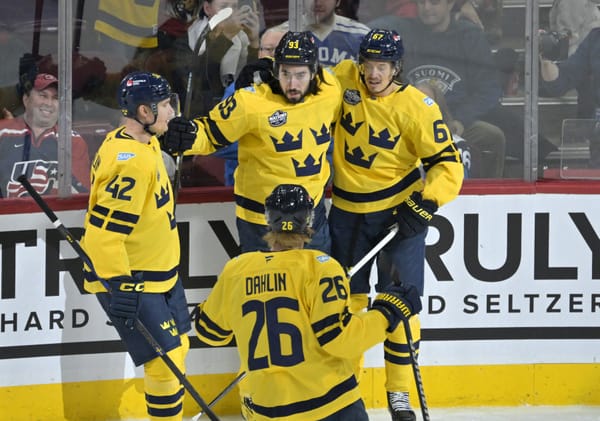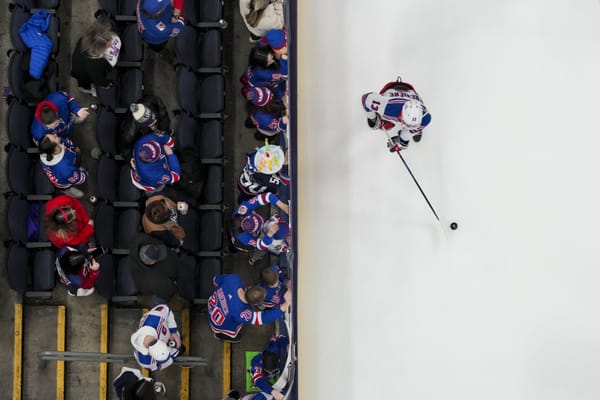Zac Jones’ sophomore season by the numbers
A national champion and a freshly signed New York Ranger
If you’re a New York Rangers fan, Zac Jones is hotter than Hansel right now.
The Rangers signed the defensive prospect an entry-level contract on April 13. He skated with the team yesterday, wearing the number 6, and could soon make his NHL debut. For the time being, the 20-year-old is soaking up as much as he can from his new teammates. So it seems only appropriate that we take a moment to soak in Jones’ final season at UMass-Amherst, which culminated in him and the Minutemen winning a national title.
Bar down. Hands up. Mama Cries#FrozenFour x 🎥 @UMassHockey pic.twitter.com/ghmEaIEGUl
— NCAA Ice Hockey (@NCAAIceHockey) April 9, 2021
Let’s start with the surface-level stats.
Jones had nine goals and 25 assists in 29 games to finish third in the nation in scoring among d-men. That was a strong showing after piling up 23 points — three of which were goals — in 32 games as a freshman in 2019-20. Although he scored six more goals as a sophomore, his 10.7 Sh% was hardly off the charts. His UMass teammate, Matthew Kessel, a St. Louis Blues prospect, had a 14.3 Sh%.
Something that jumps out right away looking at Jones’ freshman season versus his sophomore campaign is a drop in his PIM. He had 24 PIM as a freshman and took just four minors as a sophomore. I like to look at penalty stats, particularly for college defenders in the men’s and women’s game, to see how players adjust after their freshman seasons. Jones dropping from 12 minors to four minors is definitely an encouraging sign — especially when you consider that his eTOI/GP, per pick224.com, jumped up from 21.84 to 23.23 this year.
Value and Role with the Minutemen
One thing is abundantly clear about Jones: he’s not afraid to shoot. He led all Hockey East defenders with 2.9 SOG/GP, which was also good for sixth in the nation. Jones also led UMass in shots attempts at even strength (116) and on the power play (47). Overall, he attempted 9.37 percent of UMass’ total shots at evens. That percentage helps to illustrate the scope of his role in the Minutemen’s offense this year. Jones was a featured weapon all year long. UMass’ coaching staff wanted him to have the puck on his stick in the offensive zone.
What a wrister!
— Here's Your Replay ⬇️ (@HeresYourReplay) November 28, 2020
🚨 Zac Jones SH
1-1 pic.twitter.com/7O6xZIEkh0
His head coach, Greg Carvel will definitely miss him on the Minutemen’s blue line.
“Jonesy has decided to sign an NHL contract and adds to the list of exemplary players from our program who will move on and find success at the highest level of hockey,” said Carvel. “His growth has a player, both on and off of the ice, over the past two years has been truly impressive. Jonesy was one of the most coachable players I’ve had the pleasure to work with and I’m very excited for him and the future he will have in the NHL.”
Jones was second on his team in power-play points (10) this year and had points on 17.8% of the Minutemen’s even-strength goals. That may not seem like a big percentage but it’s important to remember his position and the presence of another productive defender — Kessel — on his team. Jones had a Rel EVGF% of 9.96, which led all UMass defenders and ranked fifth among the team’s skaters. He finished the year with a 72.97 EVGF%. Again, that was best among UMass’ defenders. Clearly, good things happened when he was on the ice.
Zac Jones (@NYRangers) has pushed himself to a point per game pace with @UMassHockey with three assists in their 4-0 win over New Hampshire in NCAA action.https://t.co/g48YCPfsKu pic.twitter.com/PxkavoJ0p8
— EP Rinkside (@EPRinkside) January 7, 2021
The power-play production was there but Jones did most of his scoring at even strength — 13 of his 24 points were earned at evens and nine of those points were primary. It’s perhaps a little surprising that only seven of his 15 assists (all situations) were primary but there’s no reason to hold that against him.
There aren’t a lot of worthwhile defensive metrics that are publicly available for college hockey but Jones did lead all Minutemen in blocked shots (35). That was more than twice the blocks he had as a freshman (14). Of course, that number was likely influenced by the bump in ice time and the bigger role he stepped into (and earned) in his second year at UMass.
Against the Pack
Looking for context in individual performance in college hockey can get pretty wild because of conferences, limited data, and the age range of players. Jones is 20 and turning 21 on Oct. 18. He was one of 49 defenders in the nation who was under 21 on Sep. 15 (who played at least 15 games this year). The age range among defenders goes from 19 to 25, which places Jones comfortably among the younger blueliners. That’s something to keep in mind when we compare him against his peers.
Jones’ 0.51 P1/GP (primary points-per-game) ranked seventh in the nation among defenders and he was the third-youngest player in the top-10. He ranked 18th in EV P1/GP (0.31) but was tied for second in even-strength goals (5) among blueliners. His 23.23 eTOI/GP was 19th in the nation. His 72.97 EV GF% was 15th in the nation, which obviously had a lot to do with the strength of his team — UMass finished the year with a record of 20-5-4 and the lowest SOGA/GP (24.59) in Hockey East.
When going over Jones’ numbers I couldn’t help but notice how frequently he was in the company of Cam York, the Philadelphia Flyers prospect who was the 14th pick of the 2019 Draft. York plays his college hockey at Michigan and had 20 points in 24 games. But what really stands out when comparing them to each other is how much bigger Jones’ role was in the Minutemen’s offense. That isn’t a knock on York. It’s praise for Jones and how he elevated his game in response to being asked to step into a bigger role after showing all kinds of potential as a freshman.
Jones’ college coach, Greg Carvel, feels that Jones is similar to Adam Fox. Excited yet?
Look at the confident pinch he makes in the GIF below before setting up the Minutemen’s leading scorer, Bobby Trivigno. A play like this takes guts and plenty of skill. It also showcases some of the tools that Jones has as an offensive defenseman.
Here’s @bobbytrivigno’s 10TH of the season, set up by @zacrj51 🚀#NewMass | #Flagship 🚩 pic.twitter.com/u0lkonnHGb
— UMass Hockey (@UMassHockey) March 18, 2021
The biggest strike against Jones is his play away from the puck. He’s still a work in progress in his own zone but, again, he’s 20. Carvel has sung the praises of his play away from the puck after calling him “a bit of a liability” when he first joined the Minutemen.
“When Zac got here, he was not a great defensive player… But his defensive game has come a long way,” Carvel said of Jones in mid-March. “That’s all the coaching we really do here. It’s mostly defensive, playing without the puck.”
Carvel also feels that Jones has come a long way in maturing physically. At 5-foot-10, he’ll never be the biggest skater on the ice so he had some work to do to get stronger so he wouldn’t be overpowered in puck battles in his own zone.
In short, Jones went from being a promising young offensive defenseman to a well-rounded college hockey player that could be trusted playing against the opposition’s best players. And he did that on a team that just won a national championship. That’s pretty special. And that’s what Jones is, a special prospect that the Rangers found in the third round with the 68th overall pick of the 2019 Draft.
There’s still work to do to catch him up to the NHL level — as there would be for any 20-year-old defender — but this is definitely a kid worth getting exciting about.
Data courtesy pick224.com, collegehockeynews.com, HockeyEastOnline.com.




